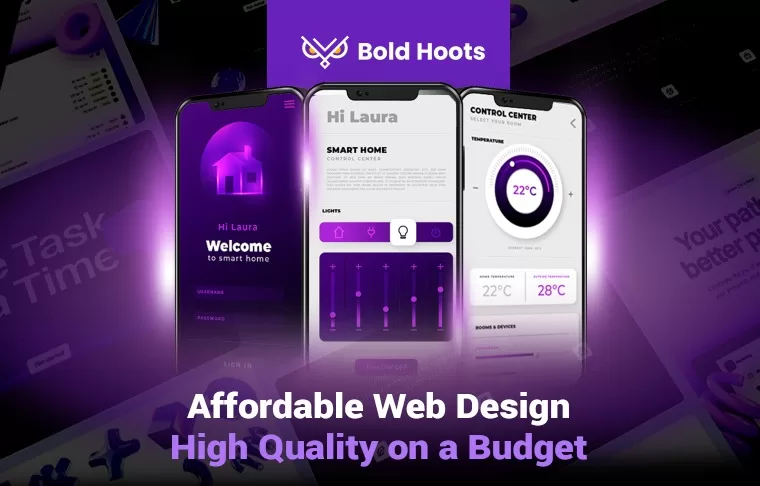Affordable Web Design: High Quality on a Budget

In today’s digital-first world, having a professional website is essential – but it shouldn’t have to break the bank. Affordable web design (also known as cheap website design) proves that you can achieve a quality online presence even with a limited budget. The key is to focus on smart strategies that maximize value without sacrificing user experience. Below, we explore how to get a great website affordably, including cost-effective tips and best practices.
Why “Affordable” Doesn’t Mean “Low Quality”
Cheap doesn’t have to mean low quality. Many small businesses successfully build attractive, effective websites on a budget by leveraging modern tools and techniques. The benefits of affordable web design are numerous – from significant cost savings to increased online visibility and customer engagement. By investing in cost-effective design solutions, you can establish a solid online presence without overspending. The goal is to maximize every dollar: spend where it counts (like user experience and mobile responsiveness) and save where possible (such as using pre-designed templates or open-source tools).Tips: Even budget websites should look professional and function smoothly. Avoid overly “bargain-basement” approaches that might lead to a clunky site – instead, make strategic choices to ensure quality. For example, using a popular Content Management System like WordPress can significantly reduce development costs while still delivering a polished result. (In fact, WordPress is often the No.1 choice for keeping web design costs down while allowing easy updates
Key Strategies for Cost-Effective Web Design
- Use the Right Platform (CMS): Choose a user-friendly, widely-supported CMS (e.g. WordPress) for your site. A good CMS enables you to edit content yourself, eliminating ongoing developer fees. It also offers countless pre-made themes and plugins, saving design time. This empowers you to keep your website updated cheaply over its lifetime.
- Prioritize Essential Content: When money is tight, less can be more. Focus on the pages and information that truly matter to your customers. It’s often unnecessary to have dozens of pages – many small-business sites find that only a handful of pages get the majority of traffic. By streamlining your content and highlighting your key products or services (maybe one well-crafted “Specials” or “Services” page instead of many low-traffic pages), you’ll keep development costs down and deliver a clearer message to visitors. Remember, users care about how you can solve their problems, not lengthy lists of every offering.
- Leverage Templates & Themes: Custom-built websites are great but can be expensive. A high-quality pre-designed website template or theme can serve as a fantastic starting point. Many affordable web design packages include responsive templates that look modern and can be tailored to your brand. This approach provides a professional look for a fraction of the cost of bespoke design.
- Optimize for SEO from the Start: Make sure your cheap website doesn’t stay invisible. Basic on-page SEO – like setting proper title tags, meta descriptions, and using relevant keywords – is something you can implement without huge costs. With the right configuration (often built into CMS plugins), even an inexpensive site can rank well on Google and attract organic traffic. As one agency notes, a budget website that’s SEO-focused can “pay for itself” many times over by generating leads. In practice, this means ensuring your site is fast, mobile-friendly, and contains content targeted to what your customers search for.
- Ensure Mobile-Friendly Design: Modern users are often on smartphones – over 92% of global internet users now access via mobile. Fortunately, making a site mobile-responsive doesn’t require extra cost if you choose the right template or theme (most are mobile-optimized out of the box). Always test your site on a phone to be sure it’s user-friendly; if your site isn’t mobile-friendly, you risk losing more than half of potential visitors immediately.
- DIY Where Possible: Take advantage of budget-friendly website builders or drag-and-drop design tools if hiring a designer is out of reach. Platforms like Wix, Squarespace, or Shopify (for e-commerce) let you build visually appealing sites cheaply. Just be mindful of their limitations and costs (e.g., subscription fees), and ensure you pick a platform that can grow with your needs.
Delivering Value Without Breaking the Bank
By following these strategies, you can achieve quality design on a budget. The aim is to spend smart: invest in elements that add credibility – like a custom domain name, reliable hosting, and a clean, user-friendly layout – and save on things that users won’t notice, such as overly fancy custom code. Always keep user experience front and center. An affordable website that is fast, easy to navigate, and clearly communicates your value proposition will perform far better than an expensive site that confuses visitors. In the end, affordable web design is about making informed choices to get the best value. With careful planning and the right resources, you can launch a website that looks professional, engages your audience, and drives business growth – all while staying within budget.Contact Bold Hoots to build a website for your business. Remember Bold Hoots creates a solutions that grows your business. So, hurry up and contact us.
